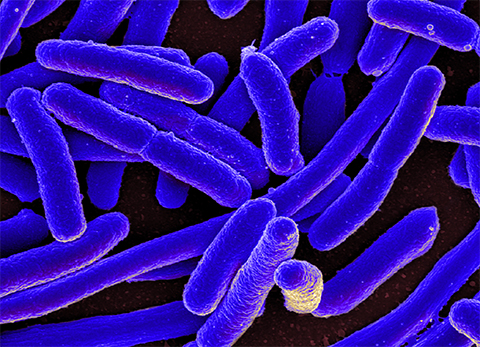
There are worse things in the water than E. coli
The world’s eyes were on Paris earlier this year as the city scrambled to meet a lofty goal: cleaning up the Seine River in time for the 2024 Summer Olympics.

Swimming was banned in the Seine for over a century because of how dirty it is, but the French government recently spent over $1 billion to build a giant underground reservoir, known as the basin of Austerlitz, to prevent wastewater from going directly into the river during periods of heavy rainfall. This infrastructure can hold the equivalent of 20 Olympic-sized swimming pools of wastewater, which is then redirected into the sewage system and treated. To inspire the public’s confidence in their dramatic clean-up efforts, Paris Mayor Anne Hidalgo even took a dip in the Seine just 10 days before the start of the games.
An imperfect metric
The most widely reported standard to determine if the Seine was clean enough to swim in was the concentration of E. coli. These bacteria occur naturally as part of a healthy gut flora, so they are typically used as an indicator of fecal contamination in water. However, many scientists believe E. coli is an imperfect metric for assessing water quality.
According to Sandra McLellan, a researcher at the University of Wisconsin–Milwaukee who studies how environmental processes can impact human health, while E. coli concentration is a standard regulatory requirement, it is not the highest tier of information that can be obtained.
“What we regulate for is different than what we can do on the research front,” she said.
Saskia Nowicki, a researcher at the University of Oxford who studies water quality risk assessment and policies, said, “It’s not to say that we shouldn’t use E. coli, because it’s still the best indicator we have so far.”
Certain pathogenic strains of E. coli can severely inflame the intestines and cause diarrhea and vomiting, a condition known as gastroenteritis. However, genome sequencing experiments to identify different E. coli strains are typically restricted to academic research settings and are not part of the routine workflow when testing water samples for fecal contamination.
“We’re monitoring E. coli because it’s telling us that there could be other pathogens there, not because we’re particularly interested in E. coli itself,” said Nowicki.
Many researchers, like McLellan, have spent decades trying to come up with better indicators for fecal contamination. McLellan noted the importance of tracking bacteria that are specific to human microbiomes, such as Bacteroidales and Lachnospiraceae. However, these are much more challenging to isolate and culture, and, as with the genotyping of E. coli strains, their detection is too complex and expensive for a routine water quality testing workflow.
“Animal waste is a health risk too, but you worry most when there’s evidence for contamination from sewage sources,” McLellan said, “because then there are all these viruses that can cause gastroenteritis, like norovirus, that can persist for a long time and get people sick even at really low concentrations.”
But E. coli isn’t a very good predictor of the presence of potential waterborne pathogens, Nowicki said. Viruses and protozoa behave differently from bacteria like E. coli. They are more resistant to disinfection with chlorine and harder to detect because they typically exist in much lower concentrations. So, the absence of E. coli doesn’t mean the absence of viral pathogens.
There’s another confounding factor: Naturalized E. coli populations can survive outside of the human body much longer than researchers expected. Both Nowicki and McLellan have observed that E. coli can persist for months in the environment, particularly on sandy beaches and in river sediments.
“There’s a residual amount of E. coli that will stay, and they can potentially wash back into the water,” McLellan said.
To Nowicki, this means that the presence of E. coli in a sample is not always necessarily linked to recent fecal contamination. In addition to naturalized populations, some E. coli is expected even in the healthiest rivers because wildlife always exists nearby, she said, and one must be aware of this when interpreting results.
“In Paris, there was always going to be a risk,” she said. “It was just a question of how much risk was tolerable.”
Heavy metal detector

While environmental scientists tackle problems associated with E. coli’s limitations as an indicator for fecal contamination, synthetic biologists are exploring its potential to detect other pollutants in water, such as heavy metals.
Allon Hochbaum and his team at the University of California, Irvine recently developed a workflow that used a nonpathogenic laboratory strain of E. coli to detect arsenic and chromium in water at concentrations up to 100,000 times lower than the World Health Organization’s recommended limits.
Their approach relies on a spectroscopy technique known as surface-enhanced Raman spectroscopy, or SERS, as well as machine learning and E. coli’s natural metabolic response to stress caused by heavy metal exposure. SERS does not detect the metals themselves, but the metabolites that E. coli produces as a stress response to being exposed to these metals.
In the field of synthetic biology, bacteria are often engineered to elicit a specific response, such as the expression of a fluorescent protein in response to a stimulus, such as the presence of a water contaminant. With this approach, scientists need to engineer one gene for each stimulus or analyte.
“What’s special about our study is that it's based on this complex metabolic machinery that responds in different ways to different toxins,” said Hochbaum.
“We also showed that even with this very basic, ubiquitous strain of bacteria, we could still differentiate between types of toxin and their concentration.”
Hochbaum said his team plans to extend the application of their approach to other water contaminants such as pesticides and per- and polyfluoroalkyl substances, or PFAs, which are often used in industry to make products water-, oil- or stain-resistant.
‘A good thing for Paris’
Due to periods of heavy rainfall throughout the Summer Games, E. coli levels in the Seine fluctuated above and below the established safety threshold of 900 colony-forming units, or CFU, per 100 milliliters. Despite the delays, uncertainties, and several athletes falling ill, all five swimming events that were scheduled to take place in the Seine proceeded as planned.
Nowicki said she thought that more time or money spent on monitoring water quality in the Seine during the games likely would not have made the French government officials’ decisions any better or easier.
“But having set that target of holding swimming events in the Seine, they’ve done more to improve the water quality than otherwise would have been possible in such a short time,” she said. “So maybe overall, it’s a good thing for Paris and for the Seine.”
Read more
Read more articles and essays about our ASBMB Molecule of the year.
Water, you say? Sephra Rampersad recalls a great scientist asking, what is the one critical component that could make or break your experiment in any lab?
Water takes center stage Danielle Guarracino remembers the role water played at two moments in her life, one doing scary experiments and one facing a health scare.
What I’ve learned about water, aging and protein quality control Alice Liu thought an increase in heat shock protein chaperones would prevent misfolding in Huntington’s disease proteins. The results surprised her, and water was the key.
The subtle strength of hydrogen bonds Indu Sridharan remembers how water complicated her atomic force microscopy imaging studies of collagen.
The teaching power of water “I questioned whether children would be very interested in this exercise; there wasn’t much to it.” At an outreach event, Jessica Desamero learns that three cups of water can convey complex science.
Water rescues the enzyme “Sometimes you must bend the rules to get what you want.” In the case of using water in the purification of calpain-2, Dorothy Croall writes, it was worth the risk.
Molecular impressions of water as cuneiform cascade Inspired by "the most elegant depiction of H2O’s colligative features," Thomas Gorrell created a seven-tiered visual cascade of Sumerian characters beginning with the ancient sign for water.
Virtual issue celebrates water in ASBMB journals Check out a dozen gold open-access articles covering exciting research about the society’s 2024 Molecule of the Year.
Enjoy reading ASBMB Today?
Become a member to receive the print edition four times a year and the digital edition monthly.
Learn moreGet the latest from ASBMB Today
Enter your email address, and we’ll send you a weekly email with recent articles, interviews and more.
Latest in Science
Science highlights or most popular articles

E-cigarettes drive irreversible lung damage via free radicals
E-cigarettes are often thought to be safer because they lack many of the carcinogens found in tobacco cigarettes. However, scientists recently found that exposure to e-cigarette vapor can cause severe, irreversible lung damage.

Using DNA barcodes to capture local biodiversity
Undergraduate at the University of California, Santa Barbara, leads citizen science initiative to engage the public in DNA barcoding to catalog local biodiversity, fostering community involvement in science.

Targeting Toxoplasma parasites and their protein accomplices
Researchers identify that a Toxoplasma gondii enzyme drives parasite's survival. Read more about this recent study from the Journal of Lipid Research.

Scavenger protein receptor aids the transport of lipoproteins
Scientists elucidated how two major splice variants of scavenger receptors affect cellular localization in endothelial cells. Read more about this recent study from the Journal of Lipid Research.

Fat cells are a culprit in osteoporosis
Scientists reveal that lipid transfer from bone marrow adipocytes to osteoblasts impairs bone formation by downregulating osteogenic proteins and inducing ferroptosis. Read more about this recent study from the Journal of Lipid Research.

Unraveling oncogenesis: What makes cancer tick?
Learn about the ASBMB 2025 symposium on oncogenic hubs: chromatin regulatory and transcriptional complexes in cancer.

